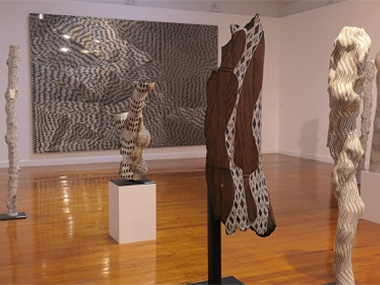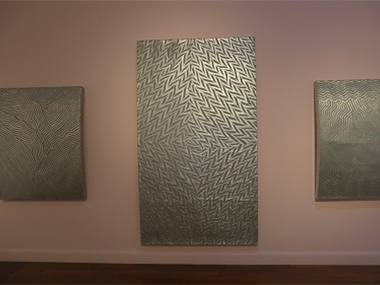'Nilimurra Dhuwal: Here We Are' by Guynbi Ganambarr

The maze of sculptures at Annandale Galleries with Guynbi Ganbambarr's 4 x 3 metre 'Guynybi Alupanel Buyku' shining on the end wall
Posted by Jeremy Eccles | 10.11.20
Gallery: Annandale Galleries
Dates:
07.11.20
Ever since his first appearance at Bill Gregory's Annandale Galleries in 2004, Guynbi Ganambarr has been making waves. Indeed, Will Stubbs, his art director at the dynamic Buku Larrnggay Art Centre in eastern Arnhemland noted that even his first appearance in 2002 was significant.
For this man (now 47), who'd been a builder at the remote outstation of Gangan while developing his cultural authority through the tutelage of the quasi-Bodhisattva elder, Gawirrin Gumana, and the current Big Man, Djambawa Marawili (whose daughter he's married), arrived at the art centre with a carved cormorant – Wurran, his mother's clan totem. This was ground-breaking for two major reasons: no one before had attempted to sculpt for sale the local ironwood – called that for good reason – and none had painted it before either. Somehow he was making “sacred art that was at once novel but still consistent with Yolngu madayin/law”.
And one might speculate that Ganambarr was also revealing a Michelangeloesque capacity to envisage his finished sculpture in the raw wood, as the Renaissance master did in blocks of marble.
He went on to be invited in to the National Sculpture Prize at the National Gallery in 2005 (what happened to that???) and to win the Xstrata Emerging Indigenous Artist Prize in 2008. He would later be invited into the second NGA Triennial, win the West Australian Indigenous Art prize and take out the Big Telstra at the NATSIAAs in 2018
At Annandale, he appeared in three Young Guns shows in the 2000s without over-exciting the horses, except for the innovation of painting his 'Wurrun' works on both sides of the bark rather than just one. Perhaps this was a foretaste of his later environmental concern for the ringbarking demise of trees when the bark is removed?
Yolngu madayin has always insisted that their sacred stories can only be told – whether for ceremony or sale – on material that comes from the land. Hence it was assumed that only bark or trunks that became larrikitj could be used if images such as Baraltja the Lightning Snake or Buyku the Fishtrap were to be portrayed. But Ganambarr was attracted to surfaces such as the huge rubber conveyor belts that miners had discarded on his Country, and managed to persuade the elders that these were 'from the land' and therefore capable of being marked with precious clan designs – miny'tji.
He would later 'find' and employ laminated board, wooden panels left behind by the Bangarra Dance Theatre, PVC pipe and aircell roof insulation panels. “I look forward to experimenting on both sides”, he told me in 2012; ”The Yolngu stories and the Balanda (whitefellar) materials – like that black mine conveyor belt. The Balanda brought that machinery in, but they're gone now. We can reuse it – especially as the trees that give us bark in the right season are dying too fast. The Yolngu have always managed the land”.
And those building skills have allowed him to control the fine engraving of old water-tanks or aluminium panels 3 metre square to create to create a dynamic illusion of fresh and salt waters clashing as is so important in many a Yolngu morality.
So Ganambarr's capacity for surprise should be almost predictable by now. But the show which opened on November 7th is a miracle of different textures and crazy angles, larrikitj that are no longer mere poles but unique sculptures, a repurposed washing machine drum, a painted S-shape of tin lazily turning in the breeze, and his largest ever incised aluminium panel, 'Guynybi Alupanel Buyku', that has been snapped up for Switzerland at $120,000. His palette nowadays resists the red, yellow and brown of his early rarrking. With such inventive shaping, he's happy to restrict himself to dense black-and-white patterning.
Notice anything inconsistent about that spelling of the word 'Guynybi' in the official title of that mighty work from Buku Larrnggay? And did you notice I'd spelt his name Guynbi at the beginning rather than the usual Gunybi? The problem is that Mr Ganambarr's given name is always pronounced Goo-in-bee – so why not spell it thus??? I asked Will Stubbs, and got the Delphic response, “The general science of linguistics is to blame for the 'ny' reversal”.
I hearby declare I'm going to spell him Guynbi in future!
Sydney Morning Herald art critic John McDonald sums up in his essay for the show: “Above all, it’s the creative freedom Guynbi claims for himself that sets him apart from just about any other artist I could name. His work becomes even more impressive when one realises that everything he does has to be carefully vetted to ensure that he doesn’t offend against community law and protocol, or claim ownership of a motif for which he has no inherited rights”.
No wonder most works are sold. But still should be seen. And, on your way into Ganambarr's room, don't miss his neighbour at Gangan, Malaluba Gumana's last ever show – for she died earlier this year. While he captures the wild waters of land and sea, she specialised in 'Dhatam', the lush water-lillies that sit upon the still waters of Arnhem billabongs, pictured meticulously though marwat, cross-hatching using a hair-brush technique.
URL: http://www.annandalegalleries.com.au/
Share this:
»  del.icio.us
»
del.icio.us
»  Digg it
»
Digg it
»  reddit
»
reddit
»  Google
»
Google
»  StumbleUpon
»
StumbleUpon
»  Technorati
»
Technorati
»  Facebook
Facebook
Contact Details
Gallery: Annandale Galleries
Contact: Bill Gregory
Email: info@annandalegalleries.com.au
Telephone: +61 2 9552 1699
Address: 110 Trafalgar Street Annandale Annandale Sydney 2038 NSW
Gallery: Annandale Galleries
Contact: Bill Gregory
Email: info@annandalegalleries.com.au
Telephone: +61 2 9552 1699
Address: 110 Trafalgar Street Annandale Annandale Sydney 2038 NSW

Teetering sculpture and the floating tin mobile with the cut-out rubber 'Buyku' in the background

The 'Garrapara' triptych incised on glittering silver foil. Pictures by Jeremy Eccles
Where is the exhibition?
Further Research
Gallery: Annandale Galleries
Artists: Djambawa Marawili | Gawirrin Gumana | Guynbi Ganambarr | Malaluba Gumana
News Tags: Annandale Galleries | Bill Gregory | Buku Larrnggay Art Centre | Gangan | Jeremy Eccles | Will Stubbs
News Categories: Australia | Blog | Exhibition | Feature | Industry | News
Exhibition Archive
- 17.11.20 | Aboriginal Art Storms Online
- 10.11.20 | 'Nilimurra Dhuwal: Here We Are' by Guynbi Ganambarr
- 06.11.20 | GORDON BENNETT SOLO IN QUEENSLAND
- 28.10.20 | The 'Seven Sisters' Heading for England
- 28.10.20 | $80K Across Seven Awards - The Big Telstra Open for Entries
- 13.10.20 | The Ebes Collection
- 12.10.20 | Sun Shines on the Wiradjuri Festival
- 06.10.20 | New Art Gallery to Open in Granville
- 25.09.20 | Archie Has First Aboriginal Winner
- 17.09.20 | Why not the Wynne?
- 27.08.20 | Goodies from Canberra
- 25.08.20 | Tarnanthi 2020
- 24.08.20 | Art Fairs Exit - and Entrance
- 12.08.20 | Fairs Fare
- 07.08.20 | “The Art of the Nation”
Advertising

